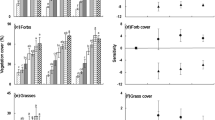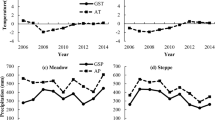Abstract
Arid and semi-arid environments are dynamic ecosystems with highly variable precipitation, resulting in diverse plant communities. Changes in the timing and magnitude of precipitation due to global climate change may further alter plant community composition in desert regions. In this study, we assessed changes in species richness and plant density at the community, functional group, and species level in response to variation in the magnitude of natural seasonal precipitation and 25% increases in seasonal precipitation [e.g., supplemental watering in summer, winter, or summer and winter (SW)] over a 5-year period in a sotol grassland in the Chihuahuan Desert. Community species richness was higher with increasing winter precipitation while community plant density increased with greater amounts of winter and summer precipitation, suggesting winter precipitation was important for species recruitment and summer precipitation promoted growth of existing species. Herb and grass density increased with increasing winter and summer precipitation, but only grass density showed a significant response to supplemental watering treatments (SW treatment plots had higher grass density). Shrubs and succulents did not exhibit changes in richness or density in response to natural or supplemental precipitation. In this 5-year study, changes in community species richness and density were driven by responses of herb and grass species that favored more frequent small precipitation events, shorter inter-pulse duration, and higher soil moisture. However, due to the long life spans of the shrub and succulent species within this community, 5 years may be insufficient to accurately evaluate their response to variable timing and magnitude of precipitation in this mid-elevation grassland.




Similar content being viewed by others
References
Abbott L (2006) Grassland ecology and diversity. Grasslands ecosystems, endangered species, and sustainable ranching in the Mexico–US borderlands. Conference proceedings June 2006, pp 11–13
Adler PB, Levine JM (2007) Contrasting relationships between precipitation and species richness in space and time. Oikos 116:221–232
Anderson JE, Inouye RS (2001) Landscape-scale changes in plant species abundance and biodiversity of a sagebrush steppe over 45 years. Ecol Monogr 71:531–556
BassiriRad H, Tremmel DC, Virginia RA, Reynolds JF, de Soyza AG, Brunell MH (1999) Short-term patterns in water and nitrogen acquisition by two desert shrubs following a simulated summer rain. Plant Ecol 145:27–36
Bates JD, Svejcar T, Miller RF, Angell RA (2006) The effects of precipitation timing on sagebrush steppe vegetation. J Arid Environ 64:670–697
Bell C, McIntyre N, Cox S, Tissue D, Zak J (2008) Soil microbial responses to temporal variations of moisture and temperature in a Chihuahuan Desert grassland. Microb Ecol 56:153–167
Briones O, Montana C, Ezcurra E (1998) Competitive intensity as a function of resource availability in a semiarid ecosystem. Oecologia 116:365–372
Buonopane M, Huenneke LF, Remmenga M (2005) Community response to removals of plant functional groups and species from a Chihuahuan Desert shrubland. Oikos 110:67–80
Cleland EE, Chiariello NR, Loarie SR, Mooney HA, Field CB (2006) Diverse responses of phenology to global changes in a grassland ecosystem. Proc Natl Acad Sci 103:13740–13744
Correll DS, Johnston MC (1979) Manual of the vascular plants of Texas. University of Texas Press, Austin
Dougherty RL, Lauenroth WK, Singh JS (1996) Response of a grassland cactus to frequency and size of rainfall events in a North American shortgrass steppe. J Ecol 84:177–183
Ehleringer JR, Schwinning S, Gebauer R (1999) Water use in arid land ecosystems. In: Press MC (ed) Advances in plant physiological ecology. Blackwell, Oxford, pp 347–365
Eviner VT, Chapin FS III, Vaughn CE (2006) Seasonal variations in plant species effects on soil N and P dynamics. Ecology 87:974–986
Field A (2000) Discovering statistics using SPSS for Windows. Cromwell Press, Trowbridge
Flato GM, Boer GJ, Lee WG, McFarlane NA, Ramsden D, Reader MC, Weaver AJ (2000) The Canadian Centre for Climate Modeling and Analysis global coupled model and its climate. Clim Dyn 16:451–467
Gibbens RP, McNeely RP, Havstad KM, Beck RF, Nolen B (2005) Vegetation changes in the Jornada Basin from 1858 to 1998. J Arid Environ 61:651–668
Goldberg D, Novoplansky A (1997) On the relative importance of competition in unproductive environments. J Ecol 85:409–418
Gross KL, Willig MR, Gough L, Inouye R, Cox SB (2000) Patterns of species density and productivity at different spatial scales in herbaceous plant communities. Oikos 89:417–427
Guo Q, Reynolds JF (2003) Historical shrub–grass transitions in the northern Chihuahuan Desert: modeling the effects of shifting rainfall seasonality and event size over a landscape gradient. Glob Change Biol 9:1475–1493
Havstad KM, Huenneke LF, Schlesinger WH (2006) Structure and function of a Chihuahuan desert ecosystem. Oxford University Press, Oxford
Heisler JL, Briggs JM, Knapp AK (2003) Long-term patterns of shrub expansion in a C4-dominated grassland: fire frequency and the dynamics of shrub cover and abundance. Am J Bot 90:423–428
Hooper DU, Johnson L (1999) Nitrogen limitation in dryland ecosystems: responses to geographical and temporal variation in precipitation. Biogeochemistry 46:247–293
Housman DC, Zitzer SF, Huxman TE, Smith SD (2003) Functional ecology of shrub seedlings after a natural recruitment event at the Nevada Desert FACE Facility. Glob Change Biol 9:718–728
Huenneke LF, Anderson JP, Remmenga M, Schlesinger WH (2002) Desertification alters patterns of aboveground net primary production in Chihuahuan ecosystems. Glob Change Biol 8:247–264
Jobbagy EG, Sala OE (2000) Controls of grass and shrub aboveground production in the Patagonian steppe. Ecol Appl 10:541–549
Johns TC, Carnell RE, Crossley JF, Gregory JM, Mitchell JFB, Senior CA, Tett SFB, Wood RA (1997) The second Hadley Centre coupled ocean atmosphere GCM: model description, spinup and validation. Clim Dyn 13:103–134
Kirkman LK, Mitchell RJ, Helton RC, Drew MB (2001) Productivity and species richness across an environmental gradient in a fire-dependent ecosystem. Am J Bot 88:2119–2128
Knapp AK, Smith MD (2001) Variation among biomes in temporal dynamics of aboveground primary production. Science 291:481–484
McGarigal K, Cushman S, Stafford S (2000) Multivariate statistics for wildlife and ecology research. Springer, New York
Muldavin EH, Moore DI, Collins SL, Wetherill KR, Lightfoot DC (2008) Aboveground net primary production dynamics in a northern Chihuahuan Desert ecosystem. Oecologia 155:123–132
Patrick L, Cable J, Potts D, Ignace D, Barron-Gafford G, Griffith A, Alpert H, van Gestel N, Robertson T, Huxman TE, Zak J, Tissue D (2007) Effects of an increase in summer precipitation on leaf, soil, and ecosystem fluxes of CO2 and H2O in a sotol grassland in Big Bend National Park, Texas. Oecologia 151:704–718
Patrick LD, Ogle K, Bell CW, Zak JC, Tissue DT (2009) Physiological responses of two contrasting desert plant species to precipitation variability are differentially regulated by soil moisture and nitrogen dynamics. Glob Change Biol 15:1214–1229
Powell AM (1998) Trees and shrubs of the Trans-Pecos and adjacent areas. University of Texas Press, Austin
Powell AM (2000) Grasses of the Trans-Pecos and adjacent areas. Iron Mountain Press, Marathon
Powell AM, Weedin JF (2004) Cacti of the Trans-Pecos and adjacent areas. Texas Tech University Press, Lubbock
Reynolds JF, Kemp PR, Tenhunen JD (2000) Effects of long-term rainfall variability on evapotranspiration and soil water distribution in the Chihuahuan Desert: a modeling analysis. Plant Ecol 150:145–159
Reynolds JF, Kemp PR, Ogle K, Fernandez RJ (2004) Modifying the ‘pulse-reserve’ paradigm for deserts of North America: precipitation pulses, soil water, and plant responses. Oecologia 141:194–210
Robertson TR, Bell CW, Zak JC, Tissue DT (2009) Precipitation timing and magnitude differentially affect aboveground annual net primary productivity in three perennial species in a Chihuahuan Desert grassland. New Phytol 181:230–242
Schenk HJ, Jackson RB (2002) Rooting depths, lateral root spreads and below ground/above-ground allometries of plants in water-limited ecosystems. J Ecol 90:480–494
Schwinning S, Ehleringer JR (2001) Water use trade-offs and optimal adaptations to pulse-driven arid ecosystems. J Ecol 89:464–480
Schwinning S, Sala OE, Loik ME, Ehleringer JR (2004) Thresholds, memory, and seasonality; understanding pulse dynamics in arid/semi-arid ecosystems. Oecologia 141:191–193
Smith RL (1996) Ecology and field biology, 5th edn. Harper Collins, New York
Walter H (1971) Ecology of tropical and subtropical vegetation. Oliver & Boyd, Edinburgh
Weltzin JF, Loik ME, Schwinning S, Williams DG, Fay PA, Haddad BM, Harte J, Huxman TE, Knapp AK, Lin G, Pockman WT, Shaw MR, Small EE, Smith MD, Smith SD, Tissue DT, Zak JC (2003) Assessing the response of terrestrial ecosystems to potential changes in precipitation. BioScience 53:941–952
Yahdjian L, Sala OE (2006) Vegetation structure constrains primary production response to water availability in the Patagonian steppe. Ecology 87:952–962
Zeiter M, Stampfli A, Newbery DM (2006) Recruitment limitation constrains local species richness and productivity in dry grassland. Ecology 87:942–951
Acknowledgments
The authors wish to acknowledge the support of the following funding agencies: National Park Service, grant (1434-01HQRU1570) to D. T. T. and J. C. Z.; USGS, grant to J. C. Z.; Department of Energy, NICCR grant to D. T. T.; ARCS, grant to T. R. R. Assistance from Dr Joe Sirotnak, John Forsythe, the BBNP fire crew, and the rest of the staff at BBNP was greatly appreciated. We would also like to thank the following people for assistance in the field: Erin Hurt, Natasja van Gestel, Elizabeth Gordon, Becky Roper, Kari Malen, April Nesbit, Colin Bell, Heath Grizzle, Dr Lisa Patrick, and Dr Michael Loik.
Author information
Authors and Affiliations
Corresponding author
Additional information
Communicated by Scott Collins.
Electronic supplementary material
Below is the link to the electronic supplementary material.
Rights and permissions
About this article
Cite this article
Robertson, T.R., Zak, J.C. & Tissue, D.T. Precipitation magnitude and timing differentially affect species richness and plant density in the sotol grassland of the Chihuahuan Desert. Oecologia 162, 185–197 (2010). https://doi.org/10.1007/s00442-009-1449-z
Received:
Accepted:
Published:
Issue Date:
DOI: https://doi.org/10.1007/s00442-009-1449-z




